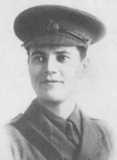West Wales Victoria Cross Winners

People from the three relatively sparsely populated counties of West Wales should be proud of the military heritage that this small part of Britain has created. The three counties of Carmarthenshire, Ceredigion and Pembrokeshire were the birthplace or home of some of the bravest soldiers and sailors that this country has known, proof being shown by the citations which accompanied the awards of the Victoria Cross to these men. The known Victoria Cross winners to have ties to these three counties are commemorated on this page.
The Hon. Augustus Henry Archibald Anson, VC, Captain, 84th Regiment (York & Lancaster Regiment). (Slebech). Augustus was born at Slebech Hall, Haverfordwest on 5 March 1835, the son of the 1st Earl of Lichfield. He was serving as a captain in the 84th (later the York & Lancaster) Regiment when he performed the deeds for which he was awarded the Victoria Cross. His citation for his deeds read: “On 28th September 1857 at Bolandshahr, India, the 9th Light Dragoons had charged through the town and were reforming on the Serai, when the enemy tried to close the entrance by drawing their carts across it. Captain Anson, taking a lance, dashed out to the gate way up and knocked the drivers off their cop’s carts. Owing to wound in his left hand, he could not stop his horse and rode it into the middle of the enemy who fired on him. At Lucknow, on 16th November 1857 he again showed great gallantry when he entered with a storming party on the gates being burst open; his horse was killed and he was slightly wounded.” Augustus later achieved the rank of Lieutenant-Colonel and was Member of Parliament for Lichfield then Bewdley. He passed away at the age of 42, on 17 December 1877, in Cannes, France, and was buried at Cimitiere Protestant du Grand Jus, Cannes. His medals are still held by the family.
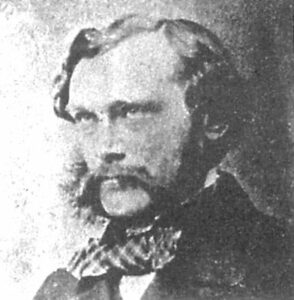
John Vaughan Campbell VC, CMG, DSO, Major, 3rd Battalion, Coldstream Guards. (Golden Grove). John was born in London on 31 October 1876, the son of Captain Ronald Campbell, brother of Earl Cawdor. His father was killed in the Zulu Wars in 1879 whilst committing an act of gallantry that would have almost certainly won him the Victoria Cross if posthumous awards had then been allowed. John was commissioned into the Coldstream Guards on 5 September 1896, and served in the Boer War where he was awarded the Distinguished Service Order, and was mentioned in Dispatches twice. He went to France with the 3rd Battalion, Coldstream Guards after the outbreak of the Great War, and he was awarded the Victoria Cross for his gallantry during the Battle of the Somme, at Ginchy on 15 September 1916. The Citation for his Victoria Cross, published in the London Gazette of 26 October 1916, read: ‘For most conspicuous bravery and leading in an attack. Seeing that the first waves of his battalion had been decimated by machine gun and rifle fire he took personal command of the third line, rallied his men with the utmost gallantry, and led them against the enemy machine guns, capturing the guns and killing the personnel. Later in the day, after consultation with other unit commanders, he again rallied the survivors of this battalion, and at a critical moment led them through a very hostile fire barrage against the objective. He was one of the first to enter the enemy trench. His personal gallantry and initiative at a very critical moment turned the fortunes of the day and enabled his division to press on and capture objectives of the highest tactical importance.’ John was made a Companion of the Order of St Michael and St George, which was published in the London gazette of 28 December 1917. The citation read: ‘The KING has been graciously pleased to give directions for the following promotions in, and appointments to, the Most Distinguished Order of Saint Michael and Saint George, for services rendered in connection with Military Operations in the Field.’ He was promoted to Brevet Colonel and Aide de Camp to The King in June 1919, and awarded the French Croix-de-Guerre in the London Gazette of 18 July 1919. John was the Regimental Lieutenant Colonel Commanding the Regiment between 1923 and 1927, and he retired on 31 October 1933. He was a member of the Honourable Corps of Gentlemen at Arms from 1934 to 1944, and during the Second World War he commanded the 8th Battalion, Gloucestershire Home Guard until his death on 22 May 1944. His only son, Captain J R Campbell was killed whilst serving with the Regiment in France in 1940.
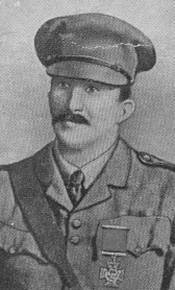
Charles Hotham Montagu Doughty-Wylie, VC, CB, CMG, Lieutenant-Colonel, Royal Welsh Fusiliers. (Bangor Teifi). Charles had been born in Suffolk, but resided at Bangor Teifi for much of his life, in between his long spells in the army as a career soldier. After graduating from Sandhurst in 1889 into the Royal Welch Fusiliers, Charles served in several campaigns, including the Chitral Expedition, the Occupation of Crete, the Mahdist War, the Second Boer War, the Boxer Rebellion, and Somaliland. Charles had been the British consul in Mersina, Turkey prior to the Great War, and was awarded the Order of the Medjidie by the Turkish Government, due to his work during the Balkan Wars. After the outbreak of the Great War, and the secret planning of the Gallipoli campaign, Charles was attached to General Sir Ian Hamilton’s headquarters staff of the Mediterranean Expeditionary Force. On 26 April 1915, following the landing at Cape Helles, Charles and another officer organized and made an attack on the village of Sedd-el-Bahr. Both were killed during the attack. Charles was posthumously awarded the Victoria Cross for his gallantry that day. The citation was published in the London Gazette of 23 June 1915, and read; ‘On 26th April 1915 subsequent to a landing having been effected on the beach at a point on the Gallipoli Peninsula, during which both Brigadier- General and Brigade Major had been killed, Lieutenant- Colonel Doughty-Wylie and Captain Walford organised and led an attack through and on both sides of the village of Sedd el Bahr on the Old Castle at the top of the hill inland. The enemy`s position was very strongly held and entrenched, and defended with concealed machine-guns and pom-poms. It was mainly due to the initiative, skill and great gallantry of these two officers that the attack was a complete success. Both were killed in the moment of victory.’ Charles is buried in an isolated grave at Seddel-Bahr.
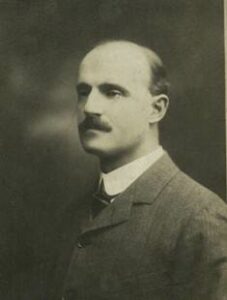
Lewis Pugh Evans, VC, CB, CMG, DSO and Bar, Brigadier-General, Black Watch (Royal Highlanders). (Llanbadarn Fawr). Lewis was born at Abermadd on 3 January 1881, the son of Sir Gruffydd Humphrey Pugh Evans, KCB, and Lady Emilia Savi Pugh Evans. Lewis was educated at Eton, and at Sandhurst before joining the Black Watch, and served with them during the Boer War. Lewis obtained his Pilot’s Certificate prior to the war, and served with the Royal Flying Corps for several months, before rejoining the 1st Battalion, Black Watch as a Lieutenant. Lewis gained his first award of the Distinguished Service Order soon after. The citation, which was published in the London Gazette of 23 July 1915, read; ‘For conspicuous gallantry and devotion to duty on June 16th, 1915, at Hooge, when, after troops had become much mixed up, he continually moved up and down the firing line under heavy fire from 10 a.m. till mid-night reorganising units and bringing back their reports.’ Early in 1917, Lewis was appointed to command the 1st Battalion, Lincolnshire Regiment. Lewis was to gain the award of the Victoria Cross that year, whilst commanding the battalion at Polygon Wood. The award was published in the London Gazette, and read; ‘For most conspicuous bravery and leadership. Lt.-Col. Evans took his battalion in perfect order through a terrific enemy barrage, personally formed up all units, and led them to the assault. While a strong machine gun emplacement was causing casualties, and the troops were working round the flank, Lt.-Col. Evans rushed at it himself and by firing his revolver through the loophole forced the garrison to capitulate. After capturing the first objective he was severely wounded in the shoulder, but refused to be bandaged, and re-formed the troops, pointed out all future objectives, and again led his battalion forward. Again badly wounded, he nevertheless continued to command until the second objective was won, and, after consolidation, collapsed from loss of blood. As there were numerous casualties, he refused assistance, and by his own efforts ultimately reached the Dressing Station. His example of cool bravery stimulated in all ranks the highest valour and determination to win.’ Later in the war Lewis gained his second award of the Distinguished Service Order, the citation of which was published in the London Gazette of 16 September 1918, and read; ‘For conspicuous gallantry and devotion to duty in a three days’ battle. On the first day he was moving about everywhere in his forward area directing operations, the next day he personally conducted a reconnaissance for a counter-attack, which was carried out on the third day. It was largely due to his untiring energy and method that the enemy were checked and finally driven out of our forward system.’ He was also mentioned in despatches seven times and was also awarded the Order of Leopold (Belgium), and the Croix de Guerre (Belgium). He was made a Companion of the Order of St Michael and St George in 1919, and a Companion of the Order of the Bath in 1938, upon retirement. Lewis served again in WW2, as Military Liaison Officer at the Headquarters of the Wales Region.
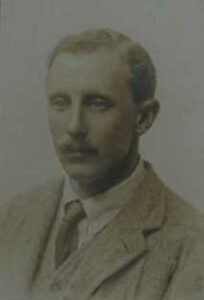
William Charles Fuller, VC, Lance Corporal, 433, 2nd Battalion, Welsh Regiment. (Laugharne). William was born in Newbridge Road, Laugharne on 24 March 1884, the son of William and Mary Fuller of Laugharne. As happened a lot at the time, William and Mary moved with their young family to Swansea, where William senior worked in Swansea Docks. William joined the Army in 1902, serving in the Boer War with the Welsh Regiment. He was recalled from the Reserve in August 1914, and went to France with the 2nd Welsh, where he won his Victoria Cross for saving Captain Mark Haggard who had fallen wounded during an attack on Chivy Ridge. William carried him a distance estimated at 100 yards to a ridge where he managed to dress the officer’s wounds. Capt Haggard asked William to fetch his rifle from where he’d fell, as he didn’t want the enemy to get it, and William managed to do this. With the help of two others, they managed to get Haggard to the safety of a barn that was being used as a First-Aid dressing station. William remained with Haggard until he died, his last words being ‘Stick it, Welch.’ After Haggard died, William attended to two other officers who had also been brought to the barn wounded. (Lt. the Hon Fitzroy Somerset and Lt. Richards.) The barn came under heavy fire and the wounded men and officers were evacuated. Later it was raised to the ground with shell-fire. On 29 October William was wounded whilst dressing the wounds of Private Tagge, a fellow soldier. Shrapnel entered his right side, twelve inches in up to his shoulder blade and came to rest on his right lung. After being evacuated from Ypres, he was sent to the United Kingdom, to Swansea Hospital where they operated, removing the shrapnel. The London Gazette Citation of 23 November 1914 read: ‘For conspicuous gallantry on 14th September 1914 near Chivy on the Aisne, by advancing about 100 yards to pick up Captain Haggard, who was mortally wounded, and carrying him back to cover under very heavy rifle and machine gun fire.’ William was given a home posting, after his recovery, as a recruiting Sergeant in Wales for the duration of the Great War. He was awarded the Royal Humane Society for Lifesaving after the war, for attempting to save a child from drowning at Mumbles, and during WW2 he served in the Swansea Home Guard. After his death, aged 90, on 29 December 1974, William Fuller was buried in Oystermouth Cemetery, Mumbles.
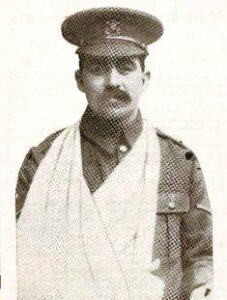
Sir James Hills-Johnes, VC, GCB, Lieutenant-General, Bengal Horse Artillery. (Dolaucothi). Sir James Hills was born on 20 August 1833, the son of James Hills, of Neechindipore, Bengal, India, and Charlotte, daughter of Angelo Savi. He was educated at the Edinburgh Academy and Addiscombe, before gaining a commission into the Bengal Artillery in 1853. James fought during several battles in India under Lord Roberts, gaining a name for his bravery in over thirty separate actions. During the Siege of Delhi, James was employed on a picket in command of two artillery guns, when he received an order to advance under escort of 80 cavalrymen. The column was surprised by a large force of the enemy, and James was left alone in front of his un-limbered guns, when the cavalry veered off. Without a thought to his own safety, James charged alone into the crowded enemy troops, firing his revolver into the mass, but was knocked down by horsemen, and slashed with a sabre from behind. James was rescued by a Captain Tombs, and for this gallant action, both men were awarded the Victoria Cross for saving the guns. The citation, which was published in the London Gazette of 24 April 1858, read; ‘On 9th July 1857, at the Siege of Delhi, India, Second Lieutenant Hills most gallantly defended the position assigned to him when attacked by enemy cavalry. Single-handed he charged the head of the enemy’s column and fought fiercely: continuing on foot after he and his horse had been ridden down. He was about to be killed with his own sword which one of the enemy had wrested from him, when his senior officer saw what was happening and twice in a short space of time came to a rescue of his subaltern.’ James later fought at the Siege of Lucknow, again alongside Lord Roberts, who would become a lifelong friend, and saw action in the Abyssynian and Afghanistan campaigns, earning himself several awards and mentions in despatches, including the C.B. and K.C.B. After a long career, he retired with the rank of Lieutenant-General, after marrying Charlotte Johnes, the daughter of John Johnes, of the Dolaucothi Estate, and assumed the surname of Hills-Johnes. James set up home with his new wife at Dolaucothi where he lived for the rest of his life, taking up a post as Honorary Colonel of the 4th Welsh, and playing an important part in recruitment in Carmarthenshire during the Great War. James died aged 85, on 3 January 1919 and is buried in Caio Churchyard. His medals are on display at the Royal Artillery Museum, Woolwich.
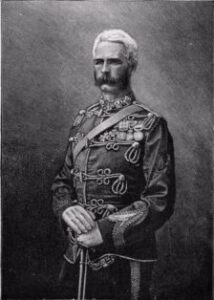
Herbert William ‘Stokey’ Lewis, VC, Private, 16224, 11th Battalion, Welsh Regiment. (Milford Haven). Herbert ‘Stokey’ Lewis was a young Milford lad, who had joined the 11th Battalion, Welsh Regiment early in the war. The battalion was known as the ‘Cardiff Pals’, due to its main strength being made up of Cardiff men. After a short spell on the Western Front, the ‘Pals’ were sent to the Mediterranean, where they fought for the remainder of the war in the Salonika campaign. It was in Salonika, during a trench raid above the village of Machukovo, Macedonia, Greece, on 22-23 October 1916, that the 20 year old Stokey Lewis gained his Victoria Cross. The citation for the award, Gazetted on Friday 15 December 1916 read; ‘For most conspicuous bravery and devotion to duty during a raid. On reaching the enemy trenches Private Lewis was twice wounded, but refused to be attended to, and showed great gallantry in searching enemy dug-outs. He was again wounded and again refused attendance. At this point three of the enemy were observed to be approaching, and Private Lewis immediately attacked them single-handed, capturing all. Subsequently, during the retirement, he went to the assistance of a wounded man, and under heavy shell and rifle fire brought him to our lines, on reaching which he collapsed. Private Lewis showed throughout a brilliant example of courage, endurance and devotion to duty.’ Although badly wounded, Stokey returned to duty, and survived the war. He became a prominent figure in Pembrokeshire life in the years after, being present at the unveiling ceremonies of many of the County War Memorials.
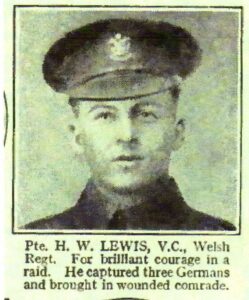
Robert Edwin Phillips, VC, Lieutenant, 9th Battalion, Royal Warwickshire Regiment. (Carmarthen). Robert was born at West Bromwich on 11 April 1895. He had worked at Carmarthen Tax office prior to the war, before enlisting into the Civil Service Rifles. Robert was initially commissioned into the 13th Battalion, Royal Warwickshire Regiment, before being posted to their 9th Battalion. His Victoria Cross was awarded for gallantry near Kut, Mesopotamia. The citation was published in the London Gazette of 8 June 1917, and read: ‘For most conspicuous bravery and devotion to duty. After his Commanding Officer had been mortally wounded in leading a counter-attack, Lt. Phillips went out under the most intense fire to his assistance, and eventually, with the help of a comrade, succeeded in bringing him back to our lines. Lt. Phillips had in the first instance tried to get a telephone wire across the open following the battalion in their counter-attack. This was impossible when the Signallers were killed. His Commanding Officer lay wounded in the open, and as the counter-attack had succeeded, he turned all his energies on getting him in. He showed sustained courage in its very highest form, and throughout he had but little chance of ever getting back alive.’ He never returned to work at Carmarthen, and died at West Bromwich in 1968, but due to his links with the town, is added here.
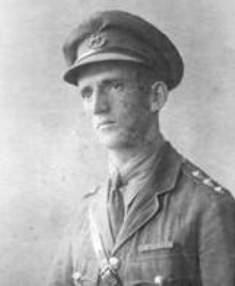
Henry James Raby, VC, Lieutenant, Royal Navy. (Llanelli). Henry was born on 26 September, 1827 at Boulogne, France, and was the son of the son of Arthur Turnour Raby, of Llanelli. He was educated at Sherborne School, before entering the Royal Navy in 1842 when he joined HMS Monarch. He was promoted to Lieutenant in 1850, and served aboard HMS Wasp on the West Coast of Africa until 1854 when the Crimean War began, and was sent to the Black Sea, where he fought in the trenches. It was as second-in-command of a ladder party on the Attack on the Redan, that he won his Victoria Cross. His citation, which was published in the London Gazette of 24 February 1857, read; ‘After the assault on Sebastopol on 18th June 1855, a soldier of the 57th Regiment, who had been shot in both legs, was seen calling for assistance. Commander Raby and two other men, Captain of the Forecastle John Taylor and Boatswain’s Mate Henry Curtis, climbed over the breastwork, all three then proceeding the 70 yards across the open space, all the time under continuous heavy fire from the enemy, making their way towards the salient angle of the Redan. They succeeded in getting the wounded man to a place of safety, all the time under the imminent risk of losing their own lives.’ Henry was the first person ever to receive the Victoria Cross at an Investiture on Hyde Park on 26 June 1857, when he was presented with the award by Queen Victoria. He was also made a Companion of the Order of the Bath (CB). He also held the Legion d’Honneur of France, the Order of Medjidie, the Crimean, Sardinian and Turkish Medals with Clasps for Sebastopol and Inkerman. His medals are on display at the Royal Naval Museum, Portsmouth. Henry eventually retired from the Royal Navy as Rear Admiral, and died on 13 February 1907 at his home, 8, Clarence Parade, Southsea, Hampshire. There are memorials on his grave at Highland Road Cemetery, Portsmouth, Hampshire and in the Town Hall, Llanelli.
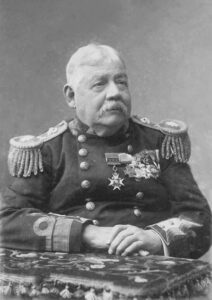
Ivor Rees, VC, Sergeant, 1032, 11th Battalion, South Wales Borderers. (Llanelli). Ivor was born on 18 October 1893 at Felinfoel, near Llanelli. He enlisted into the 11th Battalion, South Wales Borderers, part of 115 Brigade, 38th Welsh Division. He survived the terrible fighting at Mametz Wood, and moved with the Division to Ypres, where they took up positions on the Canal Bank, near Boesinghe. At Ypres, the 38th (Welsh) Division was tasked with the capture of the Pilckem Ridge-a heavily fortified German defensive line. The award of the Victoria Cross to Ivor Rees was Gazetted on 14 September 1917, and read: ‘At Pilckem, Belgium, on 31st July 1917, an enemy machine gun inflicted many casualties when it opened fire at close range. Sergeant Rees, leading his platoon, gradually worked his way round the right flank, by making short rushes, to the rear of the gun position. At 20 yards from the machine gun, Sergeant Rees rushed forward towards it, shooting one of the crew, and bayoneting the other. He bombed a large concrete emplacement, killing five of the enemy and taking 30 prisoners, including two officers and capturing a machine gun, undamaged.’ In the Second World War, Ivor served as a Sergeant-Major in the Home Guard. He died on 12 March 1967 at Llanelli, where he was buried, and is remembered on Memorials in Havard Chapel, Brecon Cathedral and at Llanelli Town Hall, Carmarthenshire.
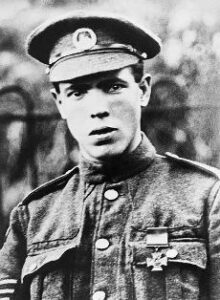
William Edward Sanders, VC, DSO, Lieutenant-Commander, Royal Naval Reserve. (Milford Haven). William was the son of Edward Helman Cook Sanders and Emma Jane Sanders, of Alexander Street, Auckland. He was a First Mate in the Mercantile Marine by the outbreak of the Great War. At the end of 1915 he joined the Royal Naval Reserve, and served as second mate of the Hebbern Jan. Obviously a promising young man, William was commissioned a Sub-Lieutenant in the Royal Naval Reserve on 19 April 1916. He attended a gunnery course before being appointed to HMS Sabrina on 11 June 1916, and later served in HMS Idaho before transferring to HMS Helgoland Morley as second in command on 6 September 1916. Recognised by the Navy for distinction, he received rapid promotion to Lieutenant in command of HMS Prize on 5 February 1917, and was made Lieutenant-Commander on 25 April 1917. HMS Prize was the first vessel to be captured from the Germans during the war, hence the name, and was a three-masted schooner. She was a ‘Q’ Ship, which was used to lure in U-Boats, and then attack them with their hidden guns- a method that proved highly successful. HMS Prize was based at Milford Haven, and it was on one of its missions from the port that William Sanders was awarded the Victoria Cross, on 30 April 1917. As the operation of these ships was highly secret, the official announcement of the Victoria Cross award in the London Gazette contained only 19 words: “In recognition of his conspicuous gallantry, consummate coolness, and skill in command of one of H.M. Ships in action”. The real story behind the award was rather more interesting. HMS Prize was on patrol south of the Irish coast when she was sighted and engaged by the German submarine U-93. Pretending to abandon ship, a crew was launched in a boat and pulled clear of the Prize, which was then shelled for half an hour by U-93. The ship was hit many times, being holed at the waterline in three places and the engine room was set on fire, but William Sanders bravely held his fire until the submarine moved in for the kill. When the enemy had closed to 80 yards, Sanders gave the order to fire. The bewildered German’s tried to escape, but her commander was knocked overboard by the body of one of his men who had been hit by a shell. When the submarine was 200 yards from Prize, a shell badly damaged her, and she stopped and looked to have sank. The submarine commander and two others of his crew were picked up by Prize, where all hands were busy repairing the badly damaged ship, before she limped back to Milford. U-93 was claimed as sunk, but her second in command managed to regain control, and brought it safely home to Germany, where he told the story about HMS Prize and her tactics. William Sanders was also awarded the Distinguished Service Order for another action against a German submarine on 12 June 1917. On 13 August 1917 HMS Prize was again on patrol when she was torpedoed and sunk by the German submarine, U-48. There were no survivors.
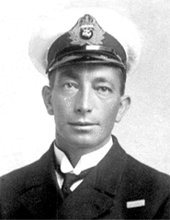
Jacob Thomas, VC, Bombardier, Bengal Artillery. (Llanwinio). Jacob was born at Llanwinio in 1833. He enlisted into the Army, and was serving in India with the Bengal Artillery, when he won his Victoria Cross. The citation which was published in the London Gazette of 24 December 1858, read; ‘At Lucknow, India, on the 27th September, 1857, when the party, to which Bombardier Thomas was attached, was returning to the Residency, after a sortie, the Bombardier, under extremely considerable difficulty, brought in, on his back, a wounded soldier of the Madras Fusiliers, thus saving him from falling into the hands of the rebels.’ Jacob died in Darjeeling, India on 5 March 1871, aged 38, and is buried in Kurseong, near Darjeeling. His medals are in the custody of the Royal Artillery Museum, Woolwich.
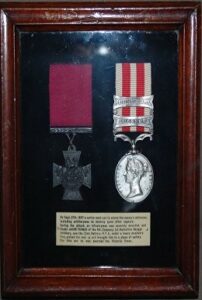
Arthur Walderne St. Clair Tisdall, VC, Sub-Lieutenant, Royal Naval Volunteer Reserve. Arthur was born in Bombay on 21 July 1890, the son of Reverend William St Clair Lomas Tisdall and Marian Louisa Tisdall (nee Gray). His father was originally from Milford Haven, but after joining the Cloth, travelled around the Empire with his young family, to spread the Mission. The family was back in England within a year of Arthur’s birth, before moving to Persia for a spell. Arthur was educated at Bedford School, before gaining a place at Trinity College, Cambridge, where he rowed and attended the Officer Training Corps, gaining a double first in classics. Arthur enlisted into the Royal Naval Volunteer Reserve as an Able Seaman on 7 October 1914 and was initially posted to HMS President, the home of the London Division of the Royal Naval Reserve. Arthur must have been an exceptional man, as within days he gained a commission to Sub Lieutenant, before being posted to Anson Battalion, of the Royal Naval Division. The division had been formed from a surplus of officers and men from within the Royal Navy, to be used as a land force. The division fought its first major action at Antwerp soon after its formation, but was evacuated before the Germans captured the port. It then regrouped and trained in England before being sent to the Mediterranean and on 25 April 1915 landed at V Beach, Gallipoli, as part of the initial landing force. Arthur disembarked from the converted ship, the SS River Clyde, with Anson Battalion, and hear some of his men calling for help, as they were under heavy fire from Turkish forces. He jumped into the water, and pushing a boat in front of him, went to their rescue. He found, however, that he could not manage alone, but managed to enlist the help of first one, and then three more naval personnel. They made five trips from the ship to the shore and were responsible for rescuing several wounded men under heavy and accurate fire, until darkness forced them to stop. Arthur survived the terrible fighting that day, but was mortally wounded by a sniper at Achi Baba on 6 May 1915. The 24-year-old died within minutes and was buried where he fell. Sadly his grave was lost during further fighting, so he is commemorated on the Helles Memorial, Gallipoli. It was to be some time before his gallantry was officially recognised, however on 31 March 1916, the following citation was published in the London Gazette, to honour the award of the Victoria Cross to Arthur:
‘During the landing from the S.S. “River Clyde” at V Beach in the Gallipoli Peninsula on the 25th April 1915, Sub-Lieutenant Tisdall, hearing wounded men on the beach calling for assistance, jumped into the water and pushing a boat in front of him, went to their rescue. He was, however, obliged to obtain help and took with him on two trips Leading Seaman Malia and on other trips Chief Petty Officer Perring and Leading Seaman Curtiss and Parkinson. In all Sub-Lieutenant Tisdall made four or five trips between the ship and the shore, and was thus responsible for rescuing several wounded men under heavy and accurate fire.
Owing to the fact that Sub-Lieutenant Tisdall and the platoon under his orders were on detached service at the time, and that this Officer was killed in action on the 6th May, it has only now been possible to obtain complete information as to the individuals who took part in this gallant act. Of these, Leading Seaman Fred Curtiss has been missing since the 4th June 1915.’
